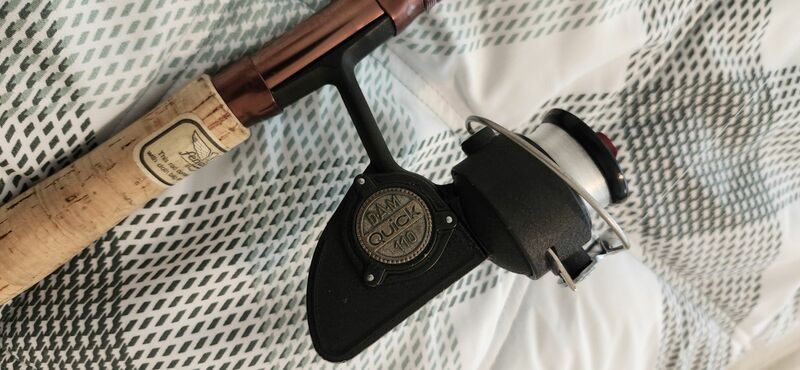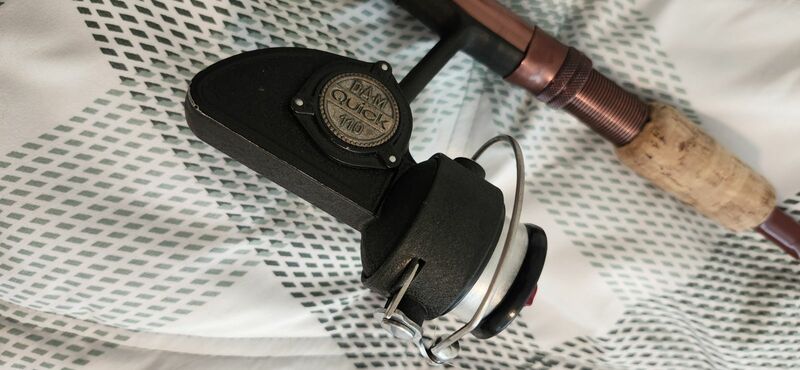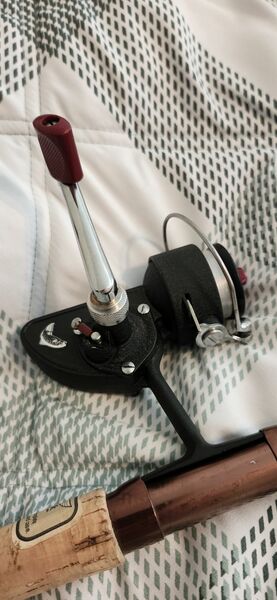A few questions about Spinning Reels (DAM Quick 110 & Shakespeare 2062)
A few questions about Spinning Reels (DAM Quick 110 & Shakespeare 2062)
Seeking advice on the proper handling & operation of older spinning reels.
Doesn't appear that the bail can be closed by hand vs turning the cranking handle. Is this common, or is there a method that I'm not aware of?
Forward & reverse mode. When forward is selected, the clicker is engaged while operating the crank.
When forward/reverse mode is enabled, the clicker is silent. What is the design intention here? It also feels like it is easier to release the bail in this mode.
I'm accustomed to more modern spinning reels & wondering why these features operate the way they do.
One reel is a Dam Quick 110 & the other is a Shakespeare 2062. What sizing & intended usage would the 2062 equate to?
Thank you.
Doesn't appear that the bail can be closed by hand vs turning the cranking handle. Is this common, or is there a method that I'm not aware of?
Forward & reverse mode. When forward is selected, the clicker is engaged while operating the crank.
When forward/reverse mode is enabled, the clicker is silent. What is the design intention here? It also feels like it is easier to release the bail in this mode.
I'm accustomed to more modern spinning reels & wondering why these features operate the way they do.
One reel is a Dam Quick 110 & the other is a Shakespeare 2062. What sizing & intended usage would the 2062 equate to?
Thank you.
Last edited by ~JM~ on Wed Jul 31, 2024 3:52 pm, edited 1 time in total.
Re: A few questions about Spinning Reels
Yes, on many older spinning reels, the bail can only be closed by turning the handle.
The “clicker” that you hear is the anti-reverse mechanism. The clicking sound is a byproduct of the design. It does not click for the sake of clicking.
When the anti-reverse is disengaged, it does not click. This is because the mechanism is disabled.
Take a look a the schematic of an old reel and you will see how the anti-reverse mechanism works. (It doesn’t necessarily need to be a spinning reel.)
The “clicker” that you hear is the anti-reverse mechanism. The clicking sound is a byproduct of the design. It does not click for the sake of clicking.
When the anti-reverse is disengaged, it does not click. This is because the mechanism is disabled.
Take a look a the schematic of an old reel and you will see how the anti-reverse mechanism works. (It doesn’t necessarily need to be a spinning reel.)
Re: A few questions about Spinning Reels
Thank you for the description. Does the clicking sound transmit down the line when retrieving a lure? Seems like it might.
Re: A few questions about Spinning Reels
No, I would not think that the click transmits down the line.
To answer one of your other questions - the Shakespeare 2062 would be an appropriate reel for largemouth bass fishing. I’d use 6# or 8# mono.
To answer one of your other questions - the Shakespeare 2062 would be an appropriate reel for largemouth bass fishing. I’d use 6# or 8# mono.
- Midway Tommy D
- Star Board Poster
- Posts: 3258
- Joined: Sun Jan 20, 2013 11:23 pm
- Location: Eastern NE
Re: A few questions about Spinning Reels
Not enough to alert or bother the fish. Think in the terms of rattling type lures, and those are on the end of the line.
As far as manually closing the bail, on some of the older style spinning reels the bail trip levers have a notched end at the bail arm that will allow a person to close the bail manually, but it's not an easy task to get used to.
Love those Open Face Spinning Reels! (Especially ABU & ABU/Zebco)
Tom DeLong, NE
ORCA Member - 2027
Tom DeLong, NE
ORCA Member - 2027
-
Paul Roberts
- Super Board Poster
- Posts: 956
- Joined: Mon Dec 14, 2020 1:35 pm
Re: A few questions about Spinning Reels
One function of the AR clicker is to let the angler know it's engaged, as more anglers back then back-reeled to fish rather than using the drag. I still do. And it is easier to bring the line to your finger to cast with the AR off, and to trip the bail, esp on older reels that may require something of a running start. Thus... came the design updates on more modern reels such as manual bail trip and silent AR on later reels.
The 2062's I've had have particularly stiff, and loud, bail tripping action. I've jokingly -and lovingly- called my 2062's "the guillotine". I've gone the extra mile to quiet them (somewhat) by adding a leather bumper and tweaking the trip mechanism (inside the rotor) to trip more easily. A truly great reel however. Still a GoTo reel for me for 8 to 12lb (talking mono) lines -I'd say the 2062's 'sweet spot' range.
I've gone the extra mile to quiet them (somewhat) by adding a leather bumper and tweaking the trip mechanism (inside the rotor) to trip more easily. A truly great reel however. Still a GoTo reel for me for 8 to 12lb (talking mono) lines -I'd say the 2062's 'sweet spot' range.
As to fish hearing the clicker: That's an interesting question. With a tight line, perhaps. But, I kind of doubt it, generally, owing to the clicker being inside the reel body fairly distant and insulated from the active line. The sound will carry from the air into the water however. With all the UW video I've done I've been amazed at how much sound (esp high frequency) emanates into the water and how far it carries! Never would have guessed.
Does all this sound disturb the fish? Big question and a longer response than I'm wanting to embark on right now. Perhaps I'll add that to my video to-do list. Generally, the UW environment is noisy, with a lot of hisses and clicks going on pretty constantly. I highly doubt that what sound might penetrate the water from a clicking reel would not bother the fish in the least. They have more important things to be interested in, and wary of.
The 2062's I've had have particularly stiff, and loud, bail tripping action. I've jokingly -and lovingly- called my 2062's "the guillotine".
As to fish hearing the clicker: That's an interesting question. With a tight line, perhaps. But, I kind of doubt it, generally, owing to the clicker being inside the reel body fairly distant and insulated from the active line. The sound will carry from the air into the water however. With all the UW video I've done I've been amazed at how much sound (esp high frequency) emanates into the water and how far it carries! Never would have guessed.
Does all this sound disturb the fish? Big question and a longer response than I'm wanting to embark on right now. Perhaps I'll add that to my video to-do list. Generally, the UW environment is noisy, with a lot of hisses and clicks going on pretty constantly. I highly doubt that what sound might penetrate the water from a clicking reel would not bother the fish in the least. They have more important things to be interested in, and wary of.
Last edited by Paul Roberts on Sat Aug 03, 2024 5:51 am, edited 1 time in total.
ORCA 2020, 2021, 2022, 2023, 2024
Re: A few questions about Spinning Reels
Thank you all. This clears up several of my concerns.
It appears that my new to me DAM Quick 110N may require servicing. It displays a partial resistance when rotating the crankshaft. It is not felt throughout the 360 degree range of rotation. Another issue is the bail release. Sometimes the reel will bind up if you are gentle with it. Then I must release the anti-reverse feature, back it up & try again with a bit more speed. It does seem to require less effort to release the bail when the anti-reverse is disengaged.
Another question. Today I took delivery of a second DAM Quick 110 (without the N) and I learned about a cork overlay for the spool. I do not have one for the 110N. I had intended to spool with 110yds. of 4# Trilene. It looks to me like the spool may be too deep.
It appears that my new to me DAM Quick 110N may require servicing. It displays a partial resistance when rotating the crankshaft. It is not felt throughout the 360 degree range of rotation. Another issue is the bail release. Sometimes the reel will bind up if you are gentle with it. Then I must release the anti-reverse feature, back it up & try again with a bit more speed. It does seem to require less effort to release the bail when the anti-reverse is disengaged.
Another question. Today I took delivery of a second DAM Quick 110 (without the N) and I learned about a cork overlay for the spool. I do not have one for the 110N. I had intended to spool with 110yds. of 4# Trilene. It looks to me like the spool may be too deep.
- Midway Tommy D
- Star Board Poster
- Posts: 3258
- Joined: Sun Jan 20, 2013 11:23 pm
- Location: Eastern NE
Re: A few questions about Spinning Reels (DAM Quick 110 & Shakespeare 2062)
You'll probably need some backing under that 4# test line to be able to fill the spool correctly. Be aware that the spools for the 110 & 110N are not interchangeable.
On another note, original grease in those older Dam reels gets thick & hard similar to bee's wax so they probably need a complete breakdown & service. Also, sometimes when old grease & lube gets stiff in spinning reels if you disengage the anti-reverse and reel backwards for a little while it will loosen the grease up and allow the reel to turn easier & smoother temporarily. It should still have a good service, though.
On another note, original grease in those older Dam reels gets thick & hard similar to bee's wax so they probably need a complete breakdown & service. Also, sometimes when old grease & lube gets stiff in spinning reels if you disengage the anti-reverse and reel backwards for a little while it will loosen the grease up and allow the reel to turn easier & smoother temporarily. It should still have a good service, though.
Love those Open Face Spinning Reels! (Especially ABU & ABU/Zebco)
Tom DeLong, NE
ORCA Member - 2027
Tom DeLong, NE
ORCA Member - 2027
-
Paul Roberts
- Super Board Poster
- Posts: 956
- Joined: Mon Dec 14, 2020 1:35 pm
Re: A few questions about Spinning Reels (DAM Quick 110 & Shakespeare 2062)
Yes, get that old grease out of there. Then you can troubleshoot from there.
ORCA 2020, 2021, 2022, 2023, 2024
Re: A few questions about Spinning Reels (DAM Quick 110 & Shakespeare 2062)
Excellent advice above from the guys. In using your efforts, favor the Quick 110 over the 110N. The 110 is easily the best of the Microlite reels, IMHO. Parts on the N model were cheapened, and it cannot be converted to right or left-handed use as the 110 can. The original Microlite used gear-driven spool oscillation and is strictly left-handed retrieve, where the 110 uses a link between the main gear and the axle for oscillation, which is quite efficient. Your 2062 is one of the best spinning reels ever made, as long as the axle tip is not plastic, as Shakespeare went to this method in late 1970. To the lower-left of the medallion on the 2062 are 2 capital letters. Look for EG, EF, EC, EB or a DA with a steel axle tip. The plastic tips crack and have a plastic (?) rotor bearing also that has more rolling resistance than the earlier steel bearing. If you have the parts from the earlier models, you can convert easily, though. Models DC and DD have plastic stuff. DA models can be either, but you can tell from the outside by the shape of the anti-reverse lever. The 2062 was a direct competitor of the Mitchell 300 and 400 and are tremendously durable. They don't break bail springs unless the user directly mishandles them, and the bail closes like a steel trap. Their internal clearances were magnificent, too.
Re: A few questions about Spinning Reels (DAM Quick 110 & Shakespeare 2062)
Not sure how important "originality" is to you, but you can make your own backing by reeling in some ordinary twine tightly to the right level on the spool, and then put tape over the twine to cover it. The only trick is to get tape of the proper width so it spans the inside of the spool properly and the line can't sneak under the tape. Neatness counts, though.
- kyreels
- Super Board Poster
- Posts: 1361
- Joined: Mon Feb 06, 2006 6:12 pm
- Location: Louisville, Kentucky
Re: A few questions about Spinning Reels (DAM Quick 110 & Shakespeare 2062)
Would love to see some pictures, since most of us have not seen all the DAM models. viewtopic.php?t=15596
Matt Wickham
Collector of Casting Weights, KY Reels and KY Tackle
Collector of Casting Weights, KY Reels and KY Tackle









